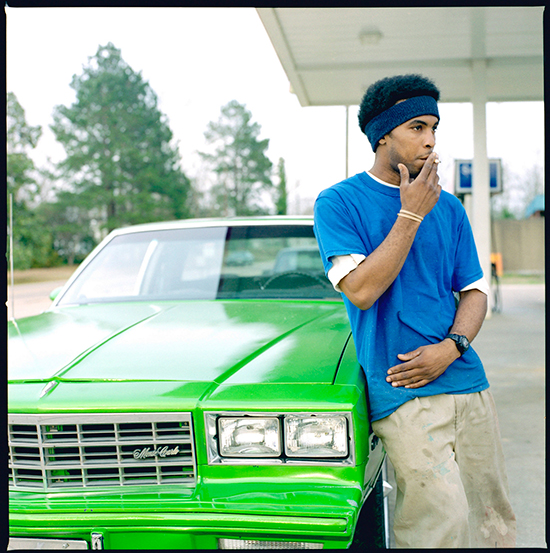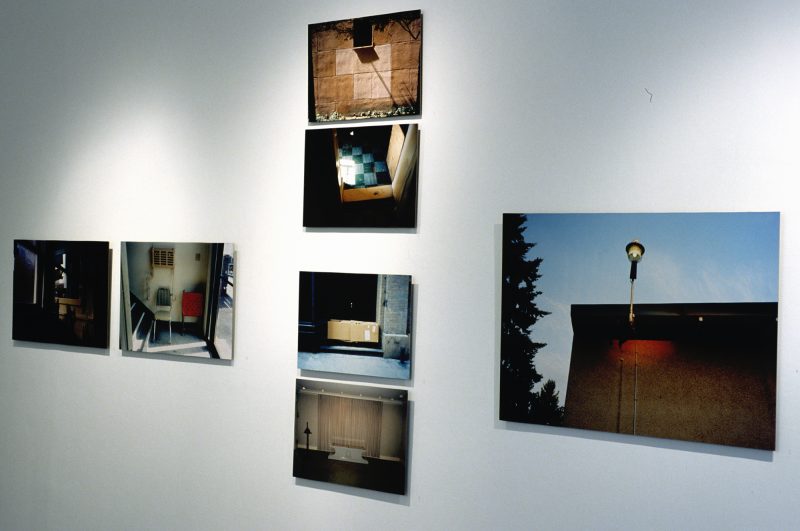Gallery 101 Curatorial 2006
GALLERY 101 presents
HERE & THERE
Curated by Guy Berube with Photography by Tony Fouhse & James Erdeg
April 6 / 2006 – May 6 / 2006
Opening Thursday, April 6, 2006 – 7:00pm
Artist talk Thursday, April 6, 2006 – 5:30pm
Closing Party at La Petite Mort Gallery:
Friday, April 28 from 7-10pm / Records by Cappo
306 Cumberland, www.guyberube.com
Admission is free and open to the public
Tony Fouhse’s photographs capture the people and places that he encountered in his travels across Canada and the USA. The work highlights the rawness and beauty of people from diverse walks of life, as well as everyday rural areas, gas stations, parking lots, and abandon stores. More than a collection of striking images, these photographs attest to the capitalist social realities faced by ordinary Canadians and Americans. An extension of Tony Fouhse’s exhibition is also on view at La Petite Mort Gallery from APRIL 7 TO MAY 4, 2006.
James Erdeg presents poetic compositions found in our everyday public spaces: a chair in the hallway waiting to be thrown out, a mat in the front porch drying in the sun; or an abstract shadow under a window sill. These images are not staged by the artist but are incidents created by people living their lives. Evoking the enigma of ephemeral moments, the works in this exhibition appeal to our own awareness of space, movement and time.
This collaboration by a non-profit artist-run centre and a commercial gallery highlights the commitment of both to promote, present and disseminate contemporary work by local artists. All exhibited works are available for sale through La Petite Mort Gallery; Gallery 101 will benefit from a percentage of the sales.
Following text extracted from email correspondences between Curator Guy Bérubé and Artists Tony Fouhse and James Erdeg, January – February, 2006. Ottawa.
INTERVIEW:
guy: Ok guys, why do you shoot pictures?
tony: I really think I take pictures so I can edit them. It also gets me out of the house. You see…I’m a gregarious loner. Given a choice, I’d stay inside all day. Shooting photos, especially photos of people, gets me out. There’s also the risk: approaching strangers, introducing yourself, working with them to create an image is full of risk.
Risk of rejection, risk of failure, risk of success. I love that risk.
Love being on the spot. And when it comes to photography, being on, and in, the correct spot is paramount. But, like I say, mostly I gather images so I can look at them later, figure out what I’m working towards and then put them into some semblance of order. I might also add that the feeling you get when you’re on the ground working, when you’re framing a shot, when you instruct your subject to look at the ground and you move a step to the left and everything in the viewfinder just snaps into place, makes sense… that feeling is fantastic.
james: The majority of the photos I take are taken alone when I’m walking around or riding my bike. I see things that I’d like to show people, little observations of the way we organize our lives.
I like the challenge of trying to convey a scenario in a single picture, as simply as possible, or to show an ambiguity. I don’t set out with a plan. I treat each scenario differently, and go back and see how the images relate to one another, and then piece things together from there. Unlike Tony, I try to eliminate all people from my work and focus on the traces left by them.
guy: Considering one shoots people, and the other shoots empty rooms, I would like for you to consider switching identities, and adopt the other’s style. Describe what you’ve shoot that day.
tony: I can’t answer that question… way too hypothetical. My work involves process, it takes time to work this shit out.
james: I could imagine a typical day for Tony involves receiving a call from the Globe & Mail photo editor, asking him to photograph Stephen Harper in person. I can imagine my dismay at having to try to prevent him from looking like a Lego man. I don’t know how Tony makes people look so natural.
tony: I don’t actually shoot for the Globe & Mail any more, but I do shoot for a ton of magazines. One of the ways I make people look natural is, I treat everyone the same. A cabinet minister or an unemployed single mother in Mississippi…
While I’m with them they’re the most interesting person in the world and I really want to know about them.
guy: Is there something that you’d love to shoot that you haven’t already had the chance?
james: I think I’ve been on a quest for the perfect image of nothing. As ridiculous as it sounds, I’d love to have the most beautiful and haunting image that evokes excitement, curiosity, and desire, but is of absolutely nothing.
tony: Nothing is a fascinating subject. Being a nihilist I kind of think everything’s really nothing. I also believe the Zen dudes when they say that it’s the imperfections that reveal the truth and beauty of things. I wonder if James’ perfect image of nothing would contain imperfections. It hurts my brain to think about that.
As to what I’d like to shoot: more, different, yet the same. Follow the line, mine the vein, live and learn.
james: I think that a lot of my work is incidental if not accidental, so maybe my perfect photo would be a perfect accident. I’m happy with mysterious accidental discoveries, possibly more so than from seeing a deliberate effort turn out exactly as planned. That’s part of the reason why I’ve resisted digital cameras; I like the surprise when the film is processed weeks, months or years later. Digital seems too deliberate for my style.
tony: I agree with James about the film/digital/surprise thing. All my personal work is still done using film. Way back when, when I was shooting 35mm, I’d go out and shoot rolls of film and never really know what I’d shot until I processed it…then I’d say to myself: “Ahhh… that’s what I was thinking”. My recent work is much more deliberate, in terms of directing the “action”, but the results still surprise me. In the end, though, I really think it doesn’t matter what camera (read: tool) you use. I like to believe it’s the talent, sensibility, sensitivity and intelligence of the operator that counts.
guy: Considering technology today, it seems anyone can be a photographer these days!
james: That’s what I like about photography today, you can have a $10 thousand camera, or a digital camera on your phone or a disposable camera, and they will each take pictures that are equally valid. Anyone can do it, sure the quality will be different, but the equipment can be in everyone’s hands. You know that I’m using a little point and shoot Olympus Stylus, which I love for its size, convenience and image quality… in the end what is there to say? I take pictures and show them to people.
Guy Bérubé is the Director of La Petite Mort Gallery. He has extensive experience as a contemporary art dealer and interior designer, and has gained solid recognition in Ottawa, New York, Paris and London. www.guyberube.com
James Erdeg obtained a BFA in photography from the University of Ottawa, 1998. His work is influenced by the work of Lynne Cohen, Charles Gagnon and Michael Schrier, to name a few. Erdeg’s solo work was presented at P’tit Bouchon (Paris, France, 2002), with upcoming solo shows at La Petite Mort Gallery, June 2006, (Ottawa), Morales Gallery, March 2006 (Montreal) and Spencer Brown Stone Gallery, March 2006, (New York). www.jameserdeg.blogspot.com
Tony Fouhse is an Ottawa-based artist, whose work encompasses contemporary and commercial photography for editorial, commercial and public purposes. His solo and group exhibitions include: Gallery 44 (Toronto), The Photography Gallery (Saskatoon), Baldwin Street Gallery of Photography (Toronto), Factory 77 (Toronto), London Regional Art Gallery (London), SAW Gallery (Ottawa), Hamm-Brickman Gallery (Rochester, NY), and Angel City Gallery (Los Angeles, NY).
Located in Ottawa, Ontario, Gallery 101 is a non-profit artist-run centre with charitable status dedicated to the professional presentation and circulation of visual and media arts. Each year, we present a stimulating array of solo and group exhibitions of Canadian and international contemporary artists working in all mediums. We also offer services and professional development opportunities to artists, curators, writers and critics. Commitment to artists and their work is our first priority.
In 1979, a small group of energetic Ottawa artists pooled their resources to establish a new non-profit gallery in which they would have control over the production and presentation of their own work. Officially incorporated as the Artists’ Centre d’Artistes, it was located at 101, Fourth Avenue. During the 1980s, Gallery 101 also organized performances, poetry readings, and music events alongside its regular exhibition programming. Media arts – including sound art, video, and experimental cinema – became an important part of our programming in the 1990s. Today, Gallery 101 continues its commitment to the visual arts in every form through its exhibitions, published monographs and catalogues. Furthermore, it has established international networks through the presentation of work by international artists and exhibitions of Canadian artists’ work abroad. Gallery 101 has a reputation for its Aboriginal and culturally diverse programming, with emphasis on presenting the diversity within Aboriginal and Inuit artistic voices. Moreover, our presentation of artists from multicultural and Franco-Ontarian identities has raised our public image as an accessible and inclusive contemporary art space.
Gallery 101 is supported by its members and patrons, The City of Ottawa, Ontario Arts Council and Canada Council for the Arts. Registered Charity #11879 0658 RR0001. To make a donation to Gallery 101, go to:
https://www.canadahelps.org/CharityProfilePage.aspx?
CharityID: s13298 for more details.
Gallery 101 is a member of Artist Run Centres and Collectives of Ontario (ARCCO).


